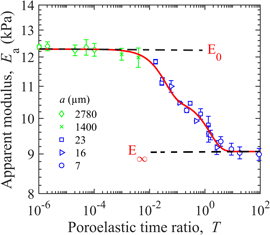Article contents
A poroelastic master curve for time-dependent and multiscale mechanics of hydrogels
Published online by Cambridge University Press: 12 November 2020
Abstract

Mechanical properties of hydrogels are of considerable interest for applications including tissue engineering and drug delivery. However, mechanical characterization of hydrogels is inherently challenging due to their multiphasic construction. Under mechanical loading, internal fluid redistribution affects the gel response, leading to a time- and length-scale-dependent material behavior, known as poroelasticity. Traditional mechanical tests are effective for determining instantaneous flow-independent gel response, and they are limited in characterizing poroelastic behavior as a function of loading time- and length-scales. Here, micro- and nanoindentation experiments are combined to characterize the full range of poroelastic behavior of a hydrogel. A master curve is presented to demonstrate that the relative competition of poroelastic relaxation time with ramp loading time determines gel response across different time- and length-scales. The master curve provides a novel mechanism to establish the instantaneous and equilibrium limits on the elastic modulus for a material, useful for designing hydrogel biomaterials.
- Type
- Article
- Information
- Copyright
- Copyright © The Author(s), 2020, published on behalf of Materials Research Society by Cambridge University Press
References
- 9
- Cited by





